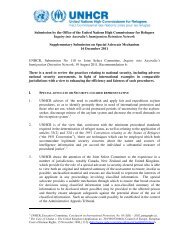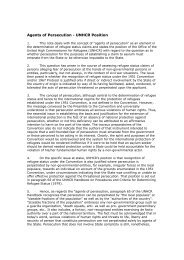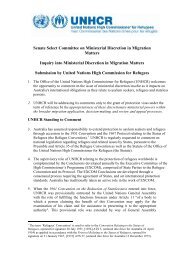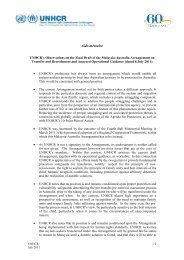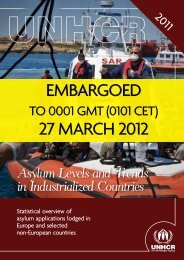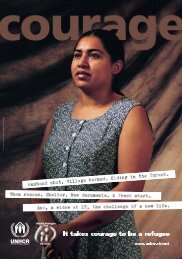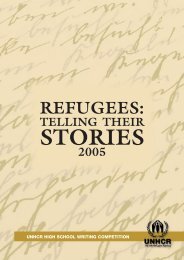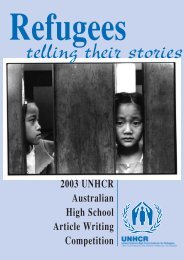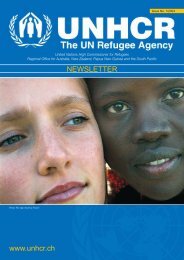Refugee Newsletter - unhcr
Refugee Newsletter - unhcr
Refugee Newsletter - unhcr
You also want an ePaper? Increase the reach of your titles
YUMPU automatically turns print PDFs into web optimized ePapers that Google loves.
Outside Baxter detention centre, near Port Augusta.Photo: UNHCR/R. MignoneBy leaving any consideration of non-Convention related protection claims to thevery end of the process and by consigningthe decision to Ministerial discretion, it canbe argued that Australia’s current practiceis inefficient, unnecessarily expensive,places an unrealistic burden on theMinister for Immigration, lackstransparency and accountability, does notcontain sufficient safeguards and isdetrimental to both Convention refugees(by clogging up the system) and to thosewith non-Convention protection needs.A New Model for AustraliaIn order to address the identifieddeficiencies in Australia’s currentTable 2: Proposed ModelApplication for Protection Visaprocedures and to ensure that Australianpractice is both consistent withinternationally recognized best practiceand the promises made by theGovernment when adopting the Agendafor Protection, Australian refugee groupsare arguing that changes are required tothe way that protection applications areconsidered.Most of the advocates believe, andinternational practice would support this,that the most efficient and cost effectiveway to consider whether a person is inneed of complementary protection is touse a single administrative procedure.This can first consider whether a person isa refugee and then, if the answer is no,assess whether there are grounds for theAssessment by Department of Immigration (DIMIA):of merits of claimand whether person meets health and character requirementsDecision to Grant<strong>Refugee</strong> StatusRecommendationto grant <strong>Refugee</strong>StatusDecision to GrantComplementaryProtectionApplicationRefusedAssessment by <strong>Refugee</strong> Review TribunalRecommendation togrant ComplementaryProtectionApplicationRefusedIntervention request to theMinister for ImmigrationUnder the proposed model, an applicant’s eligibility for complementary protection canbe assessed at each stage of the determination process, thereby ensuring that thoseentitled to protection receive it at the earliest possible time.grant of complementary protection. Table2 gives a graphic representation of thisprocess.When considering the criteria for thegrant of complementary protection, thefirst point that is necessary to stress is thatit should be used only as a supplement torefugee status and never as areplacement for it. <strong>Refugee</strong> status affordsparticular protection under internationallaw (most importantly protection fromforced return to his or her country oforigin) and where a person meets thecriteria for the grant of refugee status, thisform of protection should be used.The deliberation process wouldnecessarily involve the decision makerconsidering a series of questions in thefollowing order:a. Does the person have a well-foundedfear of persecution under the terms ofthe 1951 Convention (and thus meetthe criteria for the grant of refugeestatus)? And if not:b. Does Australia have obligations to theperson under other human rightstreaties?c. Are there other protection-relatedreasons why a person should not bereturned to his/her country of origin?As the criteria for the grant of refugeestatus are already defined in Australianlaw, it is relevant to move on to how adecision maker should go aboutanswering questions b and c.The starting point for this considerationmust be Australia’s international treatyobligations. Australia is a party to anumber of relevant international humanrights treaties:10 Discussion Paper No. 2/2005



